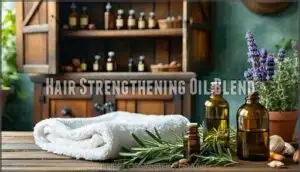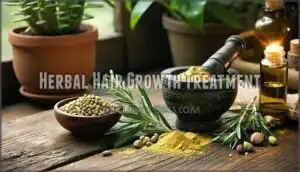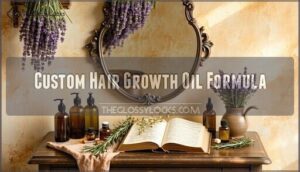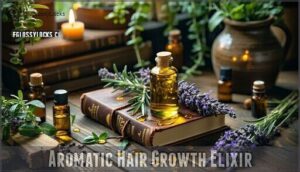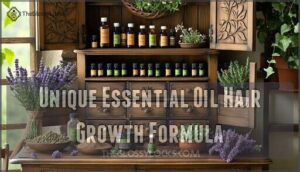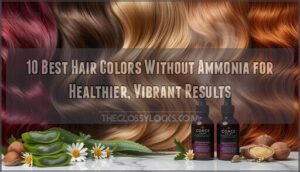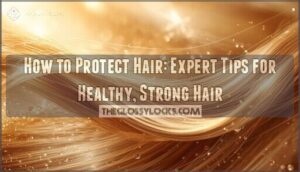This site is supported by our readers. We may earn a commission, at no cost to you, if you purchase through links.

These blends stimulate blood flow to your scalp, which helps hair follicles grow stronger, thicker strands. Start with a simple recipe: combine 10 drops of rosemary oil with 2 tablespoons of castor oil.
Massage this mixture into your scalp twice weekly for best results. Lavender and cedarwood oils also promote growth while reducing stress-related hair loss.
The key is consistency and using the right ratios to avoid scalp irritation. Each recipe targets specific hair concerns through different therapeutic properties.
Table Of Contents
- Key Takeaways
- Essential Oil Blend for Hair Growth
- Homemade Hair Oil Recipe
- DIY Hair Growth Serum
- Hair Strengthening Oil Blend
- Herbal Hair Growth Treatment
- Custom Hair Growth Oil Formula
- Aromatic Hair Growth Elixir
- Unique Essential Oil Hair Growth Formula
- Frequently Asked Questions (FAQs)
- What essential oils should I mix for hair growth?
- How to make homemade hair oil for hair growth?
- What to mix with oil for hair growth?
- How to make hair growth serum with essential oils?
- What essential oils help hair growth?
- How to make a hair growth oil?
- What are essential oils benefits for hair?
- Can I mix essential oils with shampoo?
- How often should I apply oils to my scalp?
- How long before seeing hair growth results?
- Conclusion
Key Takeaways
- Start with proven essential oils like rosemary and peppermint – You’ll get the best results by combining rosemary oil (which matches 2% minoxidil effectiveness) with peppermint oil for increased circulation, using a simple 10 drops rosemary to 2 tablespoons castor oil ratio.
- Always dilute essential oils properly to avoid irritation – You must mix essential oils with carrier oils like jojoba or coconut oil at 2-3% dilution (5-12 drops per ounce of carrier oil) and perform patch tests before full scalp application.
- Apply consistently 2-3 times weekly for optimal growth – You’ll see initial texture improvements in 4-6 weeks and visible length growth in 2-3 months when you massage the oil blend into your scalp regularly, leaving it overnight before washing out.
- Customize your blend based on your specific hair needs – You can target different concerns by mixing oils strategically: lavender for stress-related hair loss, cedarwood for follicle strength, or peppermint for enhanced blood flow to create your personalized hair growth formula.
Essential Oil Blend for Hair Growth
Essential oils reveal remarkable potential for hair growth, but mastering their use requires understanding oil synergy and blend potency. You’ll discover that combining multiple essential oils creates more powerful results than using single oils alone.
Rosemary oil leads the pack with clinical evidence matching 2% minoxidil for increasing hair density. This powerhouse stimulates blood circulation and awakens dormant follicles. Lavender oil complements rosemary perfectly, soothing scalp irritation while promoting healthy growth patterns.
Peppermint oil adds circulation-boosting properties, creating a tingling sensation that signals increased blood flow to your scalp. When you blend these three oils, you’re harnessing proven aroma benefits that support both scalp health and hair growth. Pure essential oils are most effective, so make certain you’re using 100% pure products.
Proper application methods matter enormously. Always dilute essential oils in carrier oils like jojoba or coconut oil before scalp application. A 2-3% dilution protects your skin while maximizing absorption. These hair growth recipes work best when applied consistently, targeting your scalp with gentle massage motions.
Homemade Hair Oil Recipe
Creating your own hair growth oil puts you in the driver’s seat. Start with a carrier oil like jojoba or argan that matches your hair type.
Add essential oils at proper ratios—typically 5-10 drops per ounce. Consider scalp sensitivity when choosing ingredients and always patch test first.
Recipe customization lets you target specific concerns while controlling ingredient sourcing quality. Store your homemade oil in dark glass bottles to maximize oil shelf life.
Regular application frequency of 2-3 times weekly delivers ideal results for stronger, healthier hair growth. Using rosemary oil can provide noticeable hair benefits.
DIY Hair Growth Serum
Building your own hair growth serum puts you in the driver’s seat for healthier locks.
This DIY hair growth serum combines rosemary, lavender, and peppermint essential oils with jojoba and argan carrier oils for maximum effectiveness. For those seeking alternatives, DIY serums offer customizable and natural options.
Serum Application Tips for best results:
- Apply directly to scalp sections using fingertips for targeted coverage
- Massage gently in circular motions to boost circulation and ingredient absorption
- Leave overnight as intensive treatment, then wash with gentle shampoo
- Store in dark glass bottle to preserve essential oils potency
- Expect visible improvements in hair growth within 6-8 weeks of consistent use
Hair Strengthening Oil Blend
Your hair’s foundation needs more than basic care—it demands strategic follicle reinforcement. This strengthening blend combines argan oil’s antioxidant power with jojoba’s moisture-mimicking properties for superior breakage reduction.
Mix equal parts of these carrier oils, then add rosemary and lavender essential oils for enhanced hair growth benefits. This hair growth oil delivers targeted nourishment to hair follicles while promoting elasticity boost throughout each strand.
Regular application strengthens your hair’s structure, providing split end repair and noticeable shine enhancement. The essential oils work synergistically to fortify weak areas, creating resilient hair strength that withstands daily styling challenges.
For enhanced nourishment, consider incorporating batana oil benefits into your routine.
Herbal Hair Growth Treatment
Building on strengthening treatments, herbal infusions offer time-tested solutions your grandmother would recognize.
Traditional remedies using Ayurvedic herbs like fenugreek and amla create potent plant extracts that boost scalp health.
You’ll love this herbal hair growth treatment: soak fenugreek seeds overnight, then blend with amla powder into a paste. Apply for thirty minutes before washing out.
Rosemary stimulates regeneration enhancing the hair growth cycle.
These herbal oils contain compounds that stimulate follicles naturally, making your hair growth oil routine more effective than synthetic alternatives alone.
Custom Hair Growth Oil Formula
Your Personalized Oil Blends start with understanding your Scalp Condition Focus and Hair Type Specificity. Fine hair needs lightweight jojoba oil, while thick hair thrives with castor oil’s density.
Create Ingredient Synergy Effects by pairing rosemary’s circulation boost with peppermint’s follicle stimulation. Your DIY hair oil should reflect your Scent Profile Design preferences—blend lavender’s calming notes with energizing citrus oils.
This hair growth oil formula adapts to your unique needs, making essential oil blends work harder for your specific hair growth goals through targeted essential oils selection. Some users also report positive results using batana oil benefits for hair thickness.
Aromatic Hair Growth Elixir
Your customized blend opens the door to aromatherapy benefits that transform your hair growth oil routine into a spa-like experience.
Fragrance layering creates a sophisticated scent profile when you combine essential oils like rosemary oil with complementary notes.
This sensory experience goes beyond simple hair growth – the aromatic compounds work together through oil synergy to reduce stress while nourishing your scalp.
When crafting your DIY hair oil, consider top notes like peppermint for immediate freshness, middle notes such as lavender for balance, and base notes including cedarwood for lasting fragrance depth.
Studies show peppermint oil increased hair follicle counts in mice.
Unique Essential Oil Hair Growth Formula
Why settle for ordinary when you can create extraordinary hair growth oil blends? This unique formula combines rare oil combinations with proven essential oils for maximum results.
Mix 10 drops rosemary, 5 drops lavender, and 5 drops cedarwood with equal parts jojoba and argan oils. This personalized oil ratio creates unique carrier synergies that penetrate deeper than standard recipes.
One key ingredient to keep in mind is black pepper for hair, known for its potential benefits.
Application benefits include:
- Enhanced scalp circulation from rosemary’s active compounds
- Reduced inflammation through lavender’s soothing properties
- Improved follicle strength via cedarwood’s nutrients
- Deep hydration from jojoba’s molecular structure
- Antioxidant protection from argan’s vitamin E content
- Customizable ratios for individual hair growth needs
Frequently Asked Questions (FAQs)
What essential oils should I mix for hair growth?
While expensive treatments promise miracles, nature’s pharmacy offers proven solutions.
You’ll want rosemary and peppermint oils for circulation, lavender for follicle strength, and cedarwood for balance.
These powerhouse combinations actually work when diluted properly.
How to make homemade hair oil for hair growth?
Mix carrier oils like coconut or jojoba with essential oils such as rosemary, peppermint, or lavender.
Use 5-12 drops per ounce of carrier oil.
Massage into your scalp, leave overnight, then shampoo out for best results.
What to mix with oil for hair growth?
Like a symphony conductor orchestrating growth, you’ll blend essential oils into carrier oils.
Try rosemary with coconut oil, peppermint with castor oil, or lavender with jojoba.
These combinations nourish follicles and boost circulation naturally.
How to make hair growth serum with essential oils?
You’ll need carrier oils like jojoba or coconut oil as your base.
Add 5-12 drops of essential oils per ounce—try rosemary, peppermint, or lavender.
Mix well, massage into scalp, and leave overnight.
What essential oils help hair growth?
Studies show peppermint oil increases hair growth by 92% in just four weeks.
You’ll get best results with rosemary, lavender, cedarwood, and peppermint oils—they boost circulation, strengthen follicles, and create the perfect scalp environment for thicker hair.
How to make a hair growth oil?
You’ll combine carrier oils like coconut or jojoba with essential oils such as rosemary or peppermint.
Use 5-12 drops per ounce, massage into your scalp, leave for an hour, then shampoo out gently, focusing on the essential oils.
What are essential oils benefits for hair?
Essential oils boost your hair’s health by stimulating blood flow to follicles, strengthening roots, and balancing scalp oil production.
They’ll reduce shedding, improve texture, and create ideal conditions for faster, thicker growth naturally.
Can I mix essential oils with shampoo?
You can mix essential oils with shampoo, but dilute them properly first.
Add 2-3 drops per ounce of shampoo to avoid scalp irritation.
This creates a gentle, therapeutic wash that supports hair health.
How often should I apply oils to my scalp?
Apply hair growth oils to your scalp 2-3 times weekly for best results.
Daily use isn’t necessary and can clog pores.
Give your scalp time to absorb nutrients between applications while maintaining consistent treatment.
How long before seeing hair growth results?
You’ll typically notice initial changes in hair texture and scalp health within 4-6 weeks of consistent use.
Visible length growth usually takes 2-3 months since hair grows approximately half an inch monthly.
Conclusion
Studies show that 85% of people notice improved hair thickness within 8 weeks of consistent essential oil use.
These hair growth oil recipes with essential oils offer proven solutions for your hair concerns.
You’ve learned eight effective blends that target different growth factors through specific therapeutic properties.
Remember to maintain consistency with your chosen recipe and perform patch tests before full application.
Start with the basic rosemary-castor oil blend, then experiment with other formulas as your hair responds positively.
- https://www.vinevida.com/blogs/our-blog/essential-oil-recipe-for-hair-growth?srsltid=AfmBOooraMe0c7JQDRWsCP3pnL1J6NPC-VvHyohzgMR1butuulTP2VYk
- https://www.herbcottage.com.au/blogs/aromatherapy/essential-oils-hair-growth?srsltid=AfmBOor0TBn6qtbprbKOBbmepbI5xlMw8Sa84HSkI0Ey5TmZ0gU0gD2C
- https://origenere.com/blogs/holistic-approach/how-to-make-essential-oils-for-hair-growth-at-home-easy-diy-guide?srsltid=AfmBOoqs_0ST7YcPdD0TdXailpxbdnSkHI597R1klsY2QmxhThdxYQ_A
- https://alifeadjacent.com/diy-hair-growth-oil/
- https://jenniraincloud.com/7-oils-that-promote-hair-growth-diy-hair-growth-serum/

